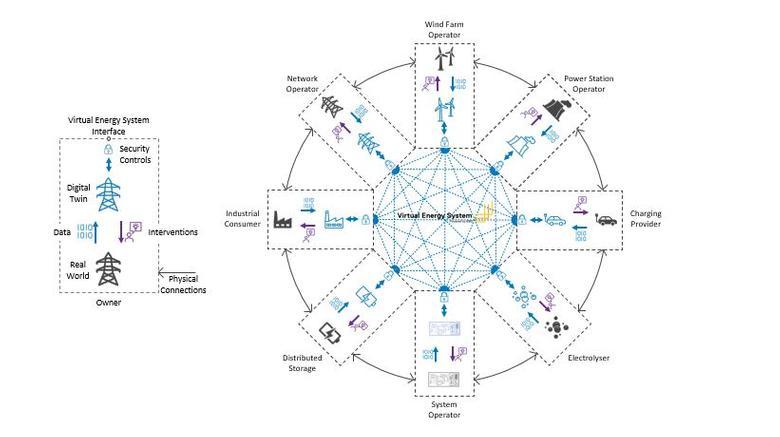How Connected Digital Twins will Power a Virtual Energy System
Britain’s energy system is transforming and is becoming more complex. As the energy transition continues, the industry will require a smart infrastructure that can capture new insights through data, enabling more informed decision making.
To support the accelerated decarbonisation of our system, energy management and ownership will become increasingly decentralised, and digitalisation will be essential to deliver a stable, secure, and cost-efficient system.
This has been recognised by leaders across the sector, including the Energy Digitalisation Taskforce, that has called for a digitalised energy system – one that will allow us to better navigate the growing complexities of the industry.
In response, at the ESO we are spearheading the development of the pioneering Virtual Energy System for Great Britain. The Virtual Energy System will be an ecosystem of connected digital twins of the GB energy system, enabling data sharing to drive innovation and deliver optimal whole system decision making.
The value of a Virtual Energy System
Existing processes within the energy sector today need to evolve to keep up with the level of automation and digital transformation taking place. A network of connected digital twins will enable the secure and resilient sharing of energy data across organisational and sector boundaries. The insights generated by the Virtual Energy System will allow us to better keep pace with industry changes, open up new market opportunities, and drive innovation by enabling more transparency.
Creating the Virtual Energy System is a socio-technical challenge, requiring a collaborative and principled approach, aligned with the National Digital Twin Programme. A common framework underpins the development of the Virtual Energy System; from how we build a strong governance model that upholds the needs of the industry to how we ensure interoperability so that data can communicate with the Virtual Energy System in a transparent and secure way.

Enabling system visibility
Like with any system, for the entire industry to understand the rules of operation and benefit from a digitalised system, we all need to be speaking the same language.
This is a challenge when the industry spans a variety of organisations, from power station operators through to consumers. These different actors all have a diverse range of standards and processes with regards to their data. To ensure they can interact and benefit from the Virtual Energy System, we need a unified set of standards so we can all share and access data in the same way.
As data owners we all have a key role to play. A paradigm shift will be crucial to encourage stakeholders to begin the process of this sharing. This is key to breaking down siloes and unlocking the potential of data that’s already available.
Where can the Virtual Energy System take us
The Virtual Energy System is already unlocking benefits for operators and consumers alike. In Wales, the ESO is helping create a digital twin of the country’s electricity system. This innovative project, Powering Wales Renewably, is funded by Ofgem’s Strategic Innovation Fund and has recently completed the Discovery phase.
This collaboration with industry partners CGI, Welsh Government, National Grid Electricity Transmission and National Grid Electricity Distribution, will help accelerate the deployment of renewables and unlock benefits such as low-cost energy generation, with a better understanding of new home-grown solutions for power supply. It will also support the country towards its target of 100% electricity generation from Welsh renewable energy sources by 2035.
As a use case for the Virtual Energy System, the project is a great example of exploring interoperability between digital twins, applying them to the real-world challenge of incorporating renewable generation and decarbonised demand. This serves as a practical demonstration of how a digital twin could be applied to accelerating progress towards net zero.
+++
By leveraging connected digital twins to enable better system oversight, the industry will be able to plan future investments with more confidence. This makes delivering an effective and efficient network, and more renewable energy onto the grid an easier task.
These benefits can only be fully enjoyed if we are collectively committed to the vision of a digitalised, decentralised and decarbonised energy system.
In collaboration with National Gas Transmission, and supported by Arup, Energy Systems Catapult, and Icebreaker One, we have just released how we intend to develop the six priority socio-technical factors of the common framework. Focusing on increasing data visibility and enabling data sharing, creating an interoperable technology stack, creating a governance framework, aligning models and taxonomies, engaging stakeholders, and raising awareness and fostering culture.
You can read more about these, and the Virtual Energy System programme, on our website:
www.nationalgrideso.com/future-energy/virtual-energy-system
Virtual Energy System email address: [email protected]
Smart Infrastructure and Systems updates
Sign-up to get the latest updates and opportunities from our Smart Infrastructure and Systems programme.


